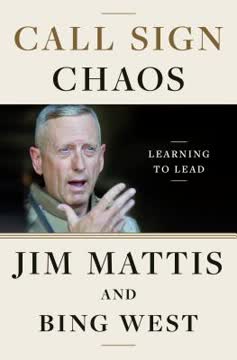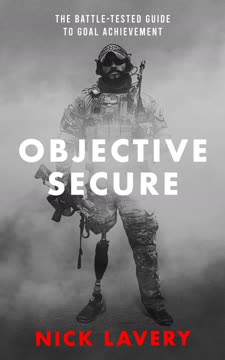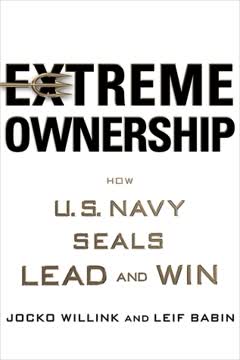Key Takeaways
1. Leadership is a balance of opposing forces
Leadership requires finding the equilibrium in the dichotomy of many seemingly contradictory qualities, between one extreme and another.
Effective leadership requires balance. Leaders must navigate between opposing forces, finding the right equilibrium for each situation. This applies to various aspects of leadership:
- Being aggressive but cautious
- Disciplined but not rigid
- A leader but also a follower
- Confident but humble
- Detail-oriented yet able to see the big picture
The key is recognizing these dichotomies and consciously working to find the right balance. No single extreme is always correct; the best leaders adapt their approach based on the specific circumstances and needs of their team and mission.
2. Take ownership, but empower others
Most underperformers don't need to be fired, they need to be led.
Extreme Ownership is crucial, but not micromanagement. Leaders must take full responsibility for their team's performance and results. However, this doesn't mean doing everything yourself or controlling every detail. Instead:
- Take ownership of the overall mission and outcomes
- Clearly communicate goals and expectations
- Provide necessary resources and support
- Empower subordinates to make decisions and take initiative
- Allow team members to own their specific tasks and roles
By balancing ownership with empowerment, leaders create a culture of responsibility throughout the organization. This approach develops future leaders and allows the team to accomplish more than any individual could alone.
3. Be disciplined, yet flexible in your approach
Standard operating procedures were not fixed, inflexible laws with no room for variation. They were guidelines that needed to be balanced with adaptability and common sense.
Discipline provides structure, but flexibility enables success. Established procedures and protocols are essential for efficiency and consistency. However, rigid adherence to rules can hinder effectiveness in dynamic situations. Leaders must:
- Develop and enforce standard operating procedures
- Train teams to execute these procedures consistently
- Encourage critical thinking and adaptation when necessary
- Allow for calculated deviations when the situation demands it
- Continuously refine and improve procedures based on experience
The goal is to create a disciplined framework that still allows for creative problem-solving and quick adjustments when faced with unexpected challenges or opportunities.
4. Train hard, but train smart
Hard training is critical to the performance of any team; this is clearly the case with SEAL platoons and task units deploying to combat zones, where we say: "You train how you fight and you fight how you train."
Effective training balances intensity with intelligence. Rigorous training is essential for developing skills, building team cohesion, and preparing for real-world challenges. However, training must be carefully designed to maximize learning and growth. Key principles include:
- Create realistic, challenging scenarios
- Push teams beyond their comfort zones
- Focus on fundamentals and repetition
- Incorporate lessons learned from past experiences
- Allow for mistakes and learning opportunities in a controlled environment
- Avoid training that's so difficult it crushes morale or inhibits learning
The goal is to create training that closely mimics real-world conditions while still providing a safe space for growth and improvement.
5. Be aggressive, not reckless
Being aggressive doesn't mean throwing caution to the wind. It doesn't mean taking catastrophic risk that can and should be mitigated.
Calculated aggression is key to success. Leaders must cultivate a proactive, problem-solving mindset within their teams. However, this aggression must be tempered with careful risk assessment and mitigation. Balanced aggression means:
- Actively seeking solutions to problems
- Taking initiative to capitalize on opportunities
- Thoroughly analyzing potential risks and rewards
- Implementing appropriate safeguards and contingency plans
- Being willing to act decisively when the situation warrants it
- Knowing when to hold back or retreat if the risk outweighs the potential gain
The goal is to create a team culture that's both bold and thoughtful, capable of seizing opportunities without unnecessary exposure to danger or failure.
6. Hold people accountable without micromanaging
Instead of using accountability as the primary tool of leadership, leaders should implement it as just one of many leadership tools.
Accountability through understanding, not constant oversight. While holding team members responsible for their actions and results is crucial, excessive monitoring can stifle initiative and growth. Effective leaders:
- Clearly communicate expectations and standards
- Explain the "why" behind tasks and missions
- Trust subordinates to execute without constant supervision
- Conduct periodic checks and reviews
- Address performance issues promptly and directly
- Recognize and reward good performance
By fostering a culture of internal accountability, leaders can ensure high standards without resorting to micromanagement. This approach develops more capable and confident team members.
7. Lead and follow: know when to do each
Every leader must be ready and willing to take charge, to make hard, crucial calls for the good of the team and the mission. That is inherent in the very term "leader." But leaders must also have the ability to follow.
Effective leadership requires both leading and following. Good leaders must be able to take charge when necessary, but also recognize when to defer to others' expertise or authority. This balance involves:
- Confidently making decisions and giving direction when appropriate
- Listening to and considering input from team members and superiors
- Recognizing and leveraging the strengths of others
- Supporting decisions made by higher-ups, even if you disagree
- Knowing when to step back and let others lead specific tasks or projects
By mastering both leading and following, leaders create a more collaborative and effective team environment.
8. Plan thoroughly, but avoid overplanning
You cannot plan for every contingency. If you try to create a solution for every single potential problem that might arise, you overwhelm your team, you overwhelm the planning process, you overcomplicate decisions for leaders.
Effective planning balances preparation with flexibility. While thorough planning is crucial for mission success, attempting to account for every possible scenario can lead to paralysis and inflexibility. Good planning involves:
- Identifying and preparing for the most likely contingencies
- Creating a clear, achievable main objective
- Developing flexible, adaptable strategies
- Focusing on key decision points and critical factors
- Leaving room for on-the-ground decision-making and adaptation
- Regularly reassessing and adjusting plans as situations evolve
The goal is to create a solid framework that guides action while allowing for quick adjustments when unexpected challenges arise.
9. Stay humble, yet assertive when necessary
Humility is the most important quality in a leader.
Humility enhances leadership effectiveness. A humble leader is open to feedback, willing to learn, and able to build strong relationships. However, humility must be balanced with the confidence to make tough decisions and stand firm when necessary. Effective leaders:
- Acknowledge their own limitations and mistakes
- Seek input and ideas from team members
- Give credit to others for successes
- Remain open to constructive criticism
- Assert themselves when the situation demands it
- Stand up for their team and push back against flawed directives
By balancing humility with assertiveness, leaders create an environment of mutual respect and continuous improvement.
10. Maintain focus while detaching for perspective
Leaders must be detached, must pull back to a position above the fray where they can see the bigger picture. That was the only way to effectively lead.
Effective leadership requires both focus and detachment. While leaders must be deeply engaged with their mission and team, they also need to step back regularly to gain a broader perspective. This balance involves:
- Staying intimately involved with day-to-day operations
- Regularly "zooming out" to assess the overall situation
- Avoiding getting bogged down in minute details
- Maintaining awareness of how individual actions impact the larger mission
- Being present in the moment while keeping long-term goals in mind
- Cultivating the ability to quickly shift between detailed focus and big-picture thinking
By mastering this balance, leaders can make better decisions, anticipate challenges, and guide their teams more effectively toward their ultimate objectives.
Last updated:
FAQ
What's The Dichotomy of Leadership about?
- Leadership Balance Focus: The book explores the balance leaders must maintain between opposing forces, such as being aggressive yet cautious, and disciplined yet flexible.
- Real-World Experiences: Authors Jocko Willink and Leif Babin share their experiences as Navy SEAL officers, illustrating how these principles apply in high-stakes situations.
- Practical Applications: It provides practical applications of leadership principles, making it relevant for both military and civilian leaders.
Why should I read The Dichotomy of Leadership?
- Valuable Leadership Insights: Offers insights into effective leadership applicable in various contexts, from military operations to corporate environments.
- Engaging Storytelling: Uses compelling narratives from combat to illustrate key concepts, making lessons memorable and relatable.
- Actionable Strategies: Provides strategies that can be implemented immediately to improve leadership effectiveness.
What are the key takeaways of The Dichotomy of Leadership?
- Balance is Essential: Effective leadership requires balancing opposing forces, such as being aggressive but not reckless, and disciplined but not rigid.
- Extreme Ownership: Leaders must take full responsibility for their actions and the outcomes of their teams, fostering a culture of accountability.
- Empowerment and Delegation: Leaders should empower subordinates while maintaining oversight, trusting team members to make decisions.
What are the best quotes from The Dichotomy of Leadership and what do they mean?
- “No bad teams, only bad leaders.”: Highlights that team performance reflects leadership quality; leaders must address issues if a team underperforms.
- “Discipline equals freedom.”: Emphasizes that strict discipline leads to greater freedom in execution, enabling effective operation and adaptability.
- “You must find the balance.”: Encapsulates the central theme of balancing opposing forces in leadership, requiring careful navigation of complexities.
What is the concept of Extreme Ownership in The Dichotomy of Leadership?
- Total Responsibility: Leaders take full responsibility for everything under their command, including successes, failures, and team actions.
- No Blame Game: Leaders analyze mistakes, learn from them, and implement changes without blaming others.
- Empowering Others: Leaders empower team members to take initiative and make decisions, fostering a culture of accountability.
How do the authors define the dichotomy of leadership?
- Opposing Forces: The need to balance opposing forces, such as being aggressive but cautious, is essential for effective leadership.
- Complexity of Leadership: Leadership involves navigating complexities, requiring adaptability and responsiveness to team and mission needs.
- Continuous Learning: Managing these dichotomies is a continuous process, with leaders remaining humble and open to learning.
What are the four Laws of Combat mentioned in The Dichotomy of Leadership?
- Cover and Move: Emphasizes teamwork and mutual support, ensuring everyone is aligned to accomplish the mission.
- Simple: Plans and orders must be simple, clear, and concise to prevent chaos and ensure understanding.
- Prioritize and Execute: Leaders assess situations, determine priorities, and communicate them to prevent overwhelm and ensure effective execution.
- Decentralized Command: Leadership should be decentralized, empowering leaders at every level to make decisions with trust and clear communication.
How does The Dichotomy of Leadership address the challenges of leadership in high-pressure situations?
- Realistic Scenarios: Shares combat experiences to illustrate challenges leaders face in high-pressure situations.
- Decision-Making Under Stress: Emphasizes making clear, decisive calls under stress, requiring calm and focus.
- Learning from Mistakes: Highlights that mistakes are inevitable, with effective leaders using them as growth opportunities.
How can leaders find the balance between being aggressive and cautious?
- Situational Awareness: Leaders assess situations to determine the appropriate level of aggression, understanding risks and rewards.
- Empowering Team Members: Encourages a culture where calculated risks are taken, allowing for aggressive action when necessary.
- Continuous Evaluation: Regularly evaluate and adjust approaches, finding the right balance through reflection and adaptability.
What is the significance of training in The Dichotomy of Leadership?
- Preparation for Challenges: Training prepares teams for real-world challenges, building skills and confidence for high-pressure situations.
- Building Cohesion: Fosters teamwork and camaraderie, with challenging training strengthening team bonds.
- Learning from Experience: Provides opportunities to learn from mistakes in a controlled environment, enhancing performance.
How does The Dichotomy of Leadership suggest leaders should handle risk?
- Assessing Risks: Carefully assess risks before making decisions, considering potential consequences on teams and missions.
- Contingency Planning: Develop contingency plans to mitigate risks, enabling quick and effective responses to unexpected situations.
- Balancing Risk and Reward: Find a balance between taking calculated risks and ensuring team safety, essential for long-term success.
What role does mentorship play in The Dichotomy of Leadership?
- Developing Team Members: Mentorship helps team members grow and reach their potential, requiring leaders to invest time and effort.
- Building Trust: Fosters trust and strengthens relationships, encouraging team members to take ownership and initiative.
- Recognizing Limitations: Leaders must recognize when someone is not a good fit, balancing mentorship with accountability for team effectiveness.
Review Summary
The Dichotomy of Leadership receives mostly positive reviews, praised for its balanced approach to leadership principles and real-world examples. Readers appreciate the emphasis on finding equilibrium in various leadership aspects. Some criticize the repetitiveness and simplicity of concepts, while others find the military focus off-putting. The book is seen as a valuable follow-up to "Extreme Ownership," offering practical insights for leaders in diverse fields. However, opinions vary on its originality and depth compared to the authors' previous work.
Similar Books










Download PDF
Download EPUB
.epub digital book format is ideal for reading ebooks on phones, tablets, and e-readers.











